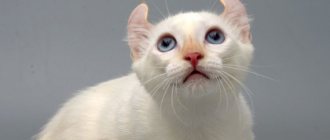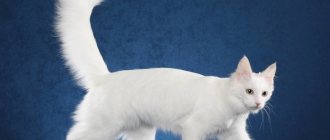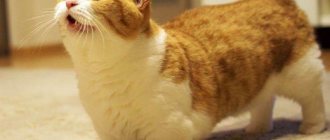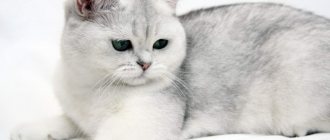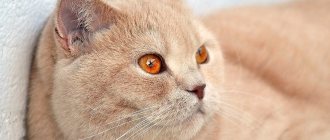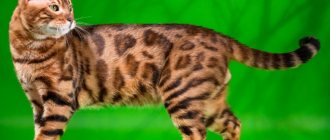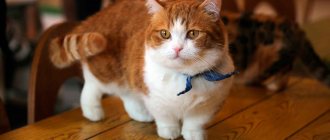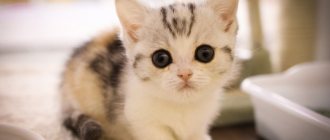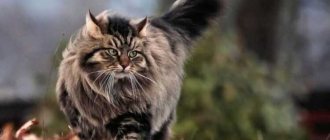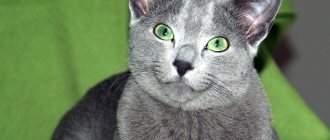Origin story
Munchkin cat breed People
first started talking about this breed in the 30s. last century. But the outbreak of the Second World War temporarily put an end to these unusual animals and their owners. Only in the 80s. The Munchkin revival has begun. This happened by pure chance. One American woman adopted an unusual kitten with short hind legs. Having become an adult cat, he gave birth to the same kittens.
The veterinarian became interested in the unusual offspring. He suggested that the owner show them to phenologists in order to register them as a new breed. There were also a lot of people willing to start breeding. For the first time these cats began to be exhibited at shows in 1991. And after a little time they gained worldwide fame. The general breed standard was established at the beginning of the 21st century, which is still valid today.
They began to actively import it to Russia in 2002. Initially, such cats were considered exotic. Now they are bred in many nurseries located in large cities and short-legged pets are no longer something outlandish.
The breed owes its name to the characters from the children's book “The Wizard of Oz” by the American writer Frank Baum. They were a fabulous people of short stature, distinguished by their peaceful and cheerful disposition.
Owner reviews
This breed appeared with us quite recently, so it does not have many reviews. We can safely say that the breed is new on our territory, so people still do not have enough knowledge about this breed of cats. In this case, it is recommended to purchase kittens from trusted nurseries. Owners point out the fact that short-haired representatives of the Munchkin breed are much easier to care for, while long-haired pets need to be brushed regularly and bathed more often.
Interesting moment! If there is a high-quality scratching post in the house, then the pet can independently cope with the process of growing claws, otherwise the owner will have to trim the pet’s claws themselves at least once a month. Feeding the animal is possible both on the basis of purchased dry, but high-quality food, and on the basis of natural food products.
Due to the fact that the breed has a tendency to overeat with subsequent obesity, it is very important to follow a feeding regime. Although this breed is considered to be quite resistant to various ailments, lordosis is a very common problem in munchkins. If there is a slight deviation associated with the curvature of the spine, excess weight of the animal can aggravate this problem by increasing the load on the heart muscle. In the case of normal weight and absence of injuries, such deviations do not affect the health of the animal in any way. The breed does not require special care, and its friendly disposition and agility are making it increasingly popular.
Brief description of the breed
The description of Munchkin cats should begin with short legs - this is their distinctive feature. This feature arose as a result of a random gene mutation. The spinal column was not affected, remaining as flexible as in normal cats. Despite their short legs, they are extremely active in movement and quick.
Munchkins have a very elongated body
They also stand out for their elongated body (like a dachshund). There are short-haired and long-haired representatives.
By nature, they are one of the most peaceful and affectionate cats. They cannot exist without constant communication with people.
Dependence of price on class
1. Show class. These are cats that best meet the standard of external characteristics and have an outstanding pedigree. Animals are distinguished by excellent health, stable psyche, and do not have developmental disabilities.
Show class kittens are not neutered; they are the standard of the breed and are allowed for breeding.
The elite class includes munchkins with the shortest legs. Show-class cats cost from 80,000 to 200,000 rubles.
2. Breeding class. The kittens also meet the standard, are healthy, can participate in exhibitions, and are allowed for breeding. But they have some disadvantages that do not allow them to be classified as the highest class.
The average cost of a kitten is 20,000 – 80,000 rubles.
3. Pet class. The cheapest animals. Such kittens do not have documents and have significant defects in appearance. Cats are not allowed for exhibitions or breeding.
Pet-class kittens cost from 2,000 to 15,000 rubles.
Little munchkin kitten/Yandex Collections
Separately, munchkin hybrids can be distinguished. Cats are crossed with representatives of other breeds.
The result is short-legged cats with the external characteristics of a certain breed. There are many munchkin hybrids, they all have their own names.
In general, they are called by a common word - dwarves (gnomes).
You can only find out how much such a cat costs from private breeders.
Hybrids are considered illegally bred, are not sold in nurseries and are much cheaper than purebred munchkins.
Breed standard
Purebred Munchkinis must meet the same characteristics
| Head | In the form of a modified wedge with rounded contours. Proportional to the body. Cheekbones – clearly defined, protruding (more in males than in females). |
| Ears | Wide at the base, slightly tapering at the top and forming rounded tips. Sizes range from medium to large. Tassels are allowed. |
| Eyes | Large, shaped like a walnut. The outer edges are slightly raised towards the ears. Planted at a considerable distance from each other. |
| Muzzle | Compact, pretty. The chin is well developed, powerful, protruding forward. The forehead is flat. |
| Nose | Medium in length. The standard allows minor deflection. |
| Neck | Thick, muscular. Males are shorter than females. |
| Frame | Long, loose. The back line has a slight slope from the shoulders to the tail. The chest is round, the hips are dense. Cats look more graceful than cats. |
| Paws | 2-3 times shorter than other cats. The back and front are the same in length. The pillows are round. |
| Tail | Voluminous throughout, tapering only towards the tip. When the cat moves, it is in a standing position. The length corresponds to the size of the case. |
The correct Munchkin breed standard.
Disadvantages are:
- strongly protruding sternum;
- nose too short or long;
- round eyes;
- stocky build;
- curly fur;
- saggy croup
Such individuals are subject to disqualification.
Munchkin colors
They do not have an unconditional list of colors. The standard does not prohibit different colors. This is due to the natural origin of animals, and not through artificial breeding.
At exhibitions you can see such cats of various colors:
- rich red;
- gray;
- white;
- chocolate;
- marble;
- black.
Unusual color of the breed
A combination of several colors, as well as the presence of spots and stripes, is allowed.
Since the breed is still experimental, it is allowed to breed cats of any color. But there are plans to develop uniform color requirements by 2025.
Genetics of Munchkin birth
The exact reason for the Munchkin's short legs has not yet been established. This mutation occurred spontaneously and did not affect other organs of the animal. Of course, breeders do not deliberately inhibit the growth of limbs with the help of special medications and other methods.
The gene responsible for this feature is selectively inherited by cats. So a litter can have kittens with both short and long legs. Work on studying the unknown gene is still underway. American scientists are especially active in this. They published the results of their many years of effort in the BioRxiv electronic repository.
Character of the breed
Munchkins have a very elongated body.
These toy creatures are devoted to their owner, like dogs. Curiosity and innate restlessness do not allow them to lie or sit quietly. They will participate in all household chores. They love it when a lot of attention is paid to them, but they themselves do not persistently ask for affection.
The friendliness and excessive contact of the Machkins allows them to find a “common language” with children. Cats are always ready to take part in games and have fun. At the same time, claws and teeth will never be used. They get along with other pets in the house without any problems. Love extends to all family members, but the owner is always the priority. It is with him that the pet develops closer communication.
Representatives of this breed are naturally intellectually developed. From the first time they learn the rules of living in the house and follow them unquestioningly. Therefore, there are no problems with training to use the tray and scratching post.
If you treat your pet kindly, the positivity and friendliness in his character does not decrease over the years. Even at an old age, they will surprise you with their agility and funny antics.
The paradox is that despite their short legs, cats move quite nimblely and deftly jump where they need to. It's true that they sway slightly when moving. Another feature of the Menchkins is silence. They meow rarely and quietly.
Health
Characteristic diseases
Due to the shortening of long bones and the normal length of the spine, as well as the desire of breeders to produce kittens with an interesting color or appearance, munchkins may suffer from the following diseases:
- Spinal lordosis occurs when an adult animal is overweight and has low mobility. The spine acquires an excessively pronounced bend in the chest area, causing internal organs to suffer. Lordosis can be prevented by providing the cat with conditions for playing and walking, and without overfeeding him.
- Genetic abnormalities leading to cardiopathy and death in young animals occur when munchkins are mated with carriers of dominant genes for lop ears or short tail. A stiff or insufficiently flexible tail may be the only sign of future heart problems in a kitten. In Europe, breeding munchkins with breeds that carry lethal genes is prohibited.
Munchkin's expressive eyes can amaze anyone
Vaccinations
All kittens that have reached the age of two months are vaccinated with Nobivak Triket, Fellovax or Multifel-4 vaccines.
These vaccines protect the baby from common viral diseases: calcivirus, panleukopenia and rhinotracheitis.
Repeated vaccination is carried out according to the schedule, no earlier than three weeks from the date of the first vaccination.
After this, the animal is vaccinated at one year of age with a multivalent vaccine containing rabies.
Rabies is considered a quarantine disease, so all domestic cats and dogs must be vaccinated against it annually.
Kittens need rabies vaccination only if they are transported within the country or abroad, as well as to attend exhibitions.
The famous munchkin pose - to look around, the cat sits on the seat and firmly rests its tail
Caring for Munchkins
Proper care will ensure the health of your pet.
From an early age to old age, Munchkins remain clean cats. They strictly use the litter box, do not throw litter around and eat food carefully. But they don’t particularly like water, so bathing them is not easy. Despite this, bathing procedures should be performed at least twice a year - in spring and autumn. Use cat shampoo. When bathing your pet, try to prevent water from entering the ears. nose, eyes. Then the animal is wrapped in a towel or dried with a hairdryer on low temperature.
Systematically examine the eyes and ears for the presence of purulent accumulations. If they are observed frequently, consult a veterinarian. Otherwise, remove them yourself with a damp cloth or cotton pad soaked in warm water. Claws are trimmed as they grow with a special tool (sold in a pet store). Additionally, a scratching post is installed in the house.
For a short-legged pet, you need to equip a separate play corner. It contains several devices for climbing, sharpening claws and various fun things. It is necessary to have toys, otherwise the cat will use any found objects for entertainment.
Diet
Each owner chooses the diet for Machkini individually. This can be industrial feed or natural food. In the first case, it is better to buy premium food that contains all the important nutritional components for the development and growth of your pet.
Natural nutrition should be balanced. The meat is taken exclusively of high quality and fresh. So, fatty pork is strictly prohibited. It is recommended to give your cat chicken, beef or veal (boiled). You also cannot throw bones, be they meat or fish. The menu must include fresh vegetables (raw and boiled).
It is not allowed to use salt when preparing dishes. Sugar is also contraindicated for them. Fatty foods are also kept to a minimum, since cats are prone to rapid weight gain.
The following products are contraindicated:
- mutton;
- legumes;
- any cereal.
A kitten should not be taught to eat from a common table.
Babies are fed up to 5 times a day, adult cats - 2 times. If you pamper your pet with food more often, then literally before your eyes he will become fat.
What to feed
Animals are not picky eaters, but still require careful selection of foods in their diet. Dry and wet food of the highest quality, or natural products are suitable for them.
They are allowed to give: lean meat, white fish, cereals, eggs and vegetables.
The following should not be included in the diet: bread, potatoes, salty soup, canned food and pasta.
Education and training
These easily trainable cats,
Munchkins are famous for their intelligence, so training them is not difficult. They understand the command perfectly and carry it out. This also applies to toilet training your pet. The main thing is not to resort to forceful methods of influence or shouting during training. This will lead to the pet becoming afraid of the owner and definitely not learning anything.
If you want to train your pet to perform different tricks, you need to start early. Adult cats are more difficult to train in a dog training center. For each completed task, do not forget to reward the purr with affection or a treat.
Types of purchase
If you are planning to buy a munchkin, you should understand that the price may depend not only on the above factors.
If you need a kitten (up to 1 year), it will cost more than an adult cat; you also need to understand where you will buy the animal: on the Internet, in a specialized store, or “from hand.” It’s clear that taking it “from hand” will be the cheapest option, maybe even free, but you won’t be sure that everything will be okay with your pet, so it’s better not to rely too much on this option.
The Internet option is more reliable, there they can provide you with all the documents for the pet, if you wish, you can agree on a price that suits you, but there is one very serious problem: you can find a cat that you really like, however, the animal may be in another city, so unforeseen difficulties may arise with transportation, and neither you nor your pet need extra stress.
If we talk about specialized stores, then everything is as simple as possible: you choose any munchkin you like, receive all the documents, pay and that’s it. There is a nuance here: you cannot agree on the price in the store, therefore, you will have to pay at the maximum rate, which is not always suitable for everyone.
Diseases and health problems
They are distinguished by strong immunity from birth. But short legs make themselves felt. This leads to some diseases of the spinal column (for example, lordosis) in many cats. As a result, the muscle frame in the chest area is weakened, which leads to problems with movement, as well as cardiac and pulmonary pathologies.
The cause of lordosis may be heredity. Therefore, experts advise trusting professional breeders when it comes to mating. Only they are able to choose the right Munchkin partner to avoid genetic diseases.
Lordosis can develop against the background of obesity. Therefore, you need to vigilantly monitor your pet’s diet, avoiding overfeeding. If the weight is exceeded, the pet is put on a diet.
Popular diseases
The most obvious problem of these cats is, of course, the back, lordosis of the spine, that is, its stretching. This problem is quite dangerous, but it is treatable; it is most often transmitted genetically. Subsequently, this disease may cause problems with other organs - liver, heart, lungs.
Another reason for this disease may be obesity. You understand how you can carry 4 kilograms of weight, or even more, on such small paws. Even overweight people have problems with their spine all the time. Therefore, owners of cats of this wonderful breed must monitor their diet, otherwise diseases will inevitably occur.
Life expectancy is 15-16 years; with proper care and an active lifestyle, this limit can reach up to 20 years.
Breeding
Breeding Munchkins should be done by professionals.
Anyone who intends to breed Munchkins must understand one thing - the gene for “short limbs” is inherited from one of the parents. If both partners are short-legged, then one hundred percent of the litter will contain dead kittens or freaks. Therefore, one of the pair must have normal paw length. This is the main reason why breeding is best done by professional breeders.
In addition to the fact that it is unacceptable to bring two Munchkins together, lop-eared and short-tailed representatives are not taken into a pair. Then the result is a small number and low-quality offspring due to the burden of additional mutagens.
Sexual maturity is reached by one and a half years. Males can be allowed to breed up to 4 times a year, but for cats it is contraindicated for health reasons to give birth more than 2 times a year. In other respects, breeding is the same as for other cats.
Application
Munchkins can be not only a cute pet, but also play the role of a true friend, like a Thai cat , act as an excellent nanny for kids and a calm, unobtrusive listener for an elderly person.
This breed is distinguished by its exceptional ability to adapt to any conditions, subtly sense all changes in a person’s mood and get along with other pets.
Munchkins have a tendency to take small things and hide them in a secluded place.
The Munchkin cat breed is ideal for beginners, as its representatives have excellent health, are not capricious in food and do not require special conditions.
Unfortunately, these cats cannot catch mice and rats due to their short front legs, and can also die if kept freely on the street, but this also applies to many other breeds of cats.
Price
If you intend to buy this amazing creation, it is not recommended to pay attention to private advertisements. There is a high probability of purchasing a surrogate or sick kitten.
The price of a kitten fluctuates. Depends on a number of points:
- purity of the family line;
- general condition of the animal;
- external compliance with breed characteristics;
- limb lengths;
- colors.
You need to buy a Munchkin from professional nurseries.
On average, the cost for representatives of this breed is 40-70 thousand rubles. Kittens that are not suitable for breeding for certain reasons, but are healthy, are much cheaper. They can be bought for 10-15 thousand rubles.
Interesting Facts
Munchkins are such an unusual breed that a lot of interesting things can be said about them. Here are a few facts worth noting:
- In our country during the existence of the USSR in the 50s. There was a similar breed of cat with short legs called the Stalingrad kangaroo. Biologists explained the appearance of this feature in cats by post-war difficulties. Soon these felines completely disappeared.
- Munchkins have one unique habit - standing on their hind legs. Periodically, they freeze in a vertical position, while holding their tail with their front paws. This may last 10 minutes or more. This is how the cat surveys the surroundings.
- Experts do not recommend knitting them together. Such a partnership leads to the birth of defective babies. The best option is when the male has a standard appearance and the female has short legs.
- Munchkinis are officially listed as the shortest cats. Thus, the American purr named Lily is listed in the Guinness Book of Records. Her height is 13.5 cm from the bottom.
- Their legs are divided into categories, depending on the length: classic - up to 20 cm, medium - up to 15 cm and shortened - no more than 13 cm. The latter option is extremely rare.
- Munchkins are often compared to magpies. This is due to their penchant for stealing everything that glitters. They store found objects in hidden places so they can play with them alone.
Graceful gait
With good living conditions and proper care, these animals can easily live up to 13 years. This is significantly less than the period allotted to classic cats. Veterinarians suggest that the reason is short legs, which leads to poor health with age.
